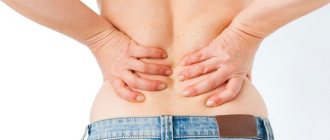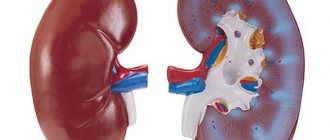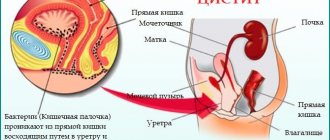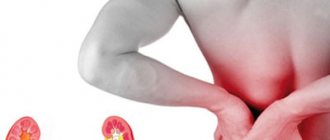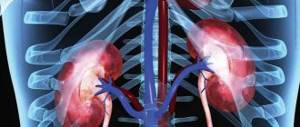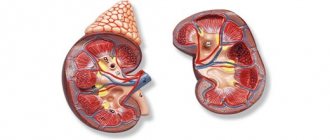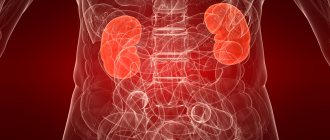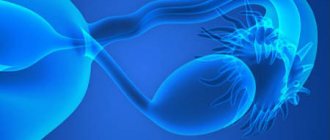General information
Renal colic (ICD-10 code - N23) is a severe acute pain attack caused by mechanical blockage of the urinary tract, which prevents the outflow of urine from the kidney itself and, as a result, disrupts the process of normal urination.
This painful condition can develop as a result of a number of urological diseases, but in the vast majority of cases its appearance is preceded by urolithiasis . Renal colic is regarded by official medicine as a severe urgent condition that requires urgent intervention by a specialist aimed at quickly relieving pain and further normalizing the functionality of the urinary system.
Definition of the concept
Renal colic is a common symptom complex characterized by intense pain in the lower back, which is caused by a violation of the outflow of urine or spasm of the muscular structures of the ureter. It is formed on the basis of existing pathologies of the urinary tract and kidneys, for example, urolithiasis.
Usually appears when the urinary tract is blocked by stones at the level of the ureters or renal pelvis. The condition is observed in absolutely any age group, but most often between the ages of 20 and 55 years. At an older age, colic diagnosed for the first time is considered a very rare occurrence.
As a rule, renal colic is unilateral.
It is a serious condition, in some cases life-threatening for the patient, and therefore requires immediate hospitalization and emergency care.
Pathogenesis
Renal colic is essentially an acute occlusion (obstruction) of the upper urinary tract due to external compression or internal blockage. Severe pain accompanying renal colic occurs due to spastic reflex contraction of the muscle tissue of the ureter, increased hydrostatic intrapelvic pressure, swelling of the parenchyma, venous stasis, stretching of the fibrous renal capsule and ischemia of the kidney, which leads to severe irritation of sensitive pain receptors.
Three stages of development of renal colic can be distinguished, namely:
Acute phase
A painful attack occurs suddenly, often against the background of completely normal health. If this occurs during sleep, severe pain causes the patient to wake up. If you are awake, you can confidently record the time of onset of renal colic.
The intensity of the pain is usually constant, but may increase over time, gradually reaching its peak over a period of approximately several hours. The level of pain depends on the person’s personal sensitivity and the rate of increase in fluid pressure in the ureter and renal pelvis. As the frequency of contractions of the ureter increases, the element obstructing the outflow of urine may move, which most often causes renewed or intensified pain.
Constant phase
Usually it occurs after a few hours, when the pain reaches its limit and can continue for quite a long time. This phase is characterized by the highest degree of pain for the patient, which in some cases can last up to 12 hours, but most often lasts 2-4 hours. It is during this phase that patients, as a rule, seek medical help, since it is simply impossible to endure such pain for a long time.
Decay phase
The final phase of renal colic begins after eliminating the cause that disrupts the patency of the urinary tract, which can happen with or without medical help. During this period, a sharp relief of pain is felt, and subsequently a gradual decrease in its intensity until complete cessation. If the occlusion is eliminated independently (for example, when a stone comes out), pain can go away at any time after an outbreak of renal colic.
Possible complications
This symptom signals pathological processes inside the body; if not treated in a timely manner, acute complications can occur. The following 8 processes are most common:
- Pain shock is a phenomenon that occurs when there is sharp and severe pain and has a harmful effect on the nervous, respiratory and cardiovascular systems.
- Pyelonephritis is inflammation of the pelvis and kidney parenchyma.
- Urosepsis is characterized by the generalization of a urinary infection, which leads to death.
- Prolonged urinary retention - a violation of the outflow of urine leads to the inability to completely empty the bladder.
- Pyonephrosis is a purulent-destructive process inside the kidney.
- Nephrosclerosis is a phenomenon in which the renal parenchyma is replaced by connective tissue, which impairs the functioning of the kidney and leads to complete atrophy of the organ.
- Hydronephrosis is characterized by expansion of the pyelocaliceal system.
- Narrowing of the urethra - the mucous membrane is replaced with scar tissue, leading to atrophy of the urethral fibers.
Classification
Conventionally, renal colic can be divided into several types, depending on certain external and internal factors.
By focusing the main pain
- left-handed;
- right-sided;
- bilateral.
According to the type of pathology
- first appeared;
- recurrent.
Due to the occurrence
- colic due to kidney stones ;
- colic due to pyelonephritis ;
- colic due to the growth of a perinephric tumor ;
- colic due to renal bleeding;
- colic due to vascular pathologies in the perinephric space;
- colic of unspecified cause.
Causes of renal colic
The cause of renal colic is a variety of mechanical obstacles that disrupt or completely stop the outflow of urine from the ureter and renal pelvis. a calculus ) is strangulated in any part of the ureter , corresponding to the type of urolithiasis (oxalates, urates, phosphates, etc.).
Urolithiasis disease
pyelonephritis , as well as necrotic rejected papillae or caseous masses formed during kidney tuberculosis , can sometimes enter the lumen of .
In addition, ureteral strictures, kidney dystopia , or torsion or kinking of the ureter, which occurs with nephroptosis . In turn, external compression of the urinary tract is quite often observed with renal tumors (papillary adenocarcinoma ), prostate tumors ( prostate cancer or adenoma ) and ureter. Renal colic can also be caused by post-traumatic subcapsular and retroperitoneal hematomas, including hematomas formed after extracorporeal lithotripsy .
Other causes that contribute to the occurrence of renal colic are associated with congestive or inflammatory pathologies of the urinary tract. For example, such painful attacks often develop with prostatitis , hydronephrosis , urethritis , periurethritis (in the case of acute segmental swelling of the mucosa) and venous phlebostasis in the pelvis. Occasionally, renal colic accompanies acute vascular pathologies of the urinary tract and occurs with embolism or thrombosis of the renal veins , as well as renal infarction . Likewise, colic in the kidneys occasionally occurs with congenital renal anomalies, such as: spongy kidney, achalasia , megacalycosis , dyskinesia , etc.
Healthy kidney and kidney with hydronephrosis
Typically, an attack of renal colic is not directly related to the intensity of physical activity, but its development can be facilitated by heavy food or drink, stressful situations, bumpy roads, heavy lifting, falls from heights, and diuretics.
Prevention
After neutralizing the painful attack of renal colic and treating the underlying disease, a rehabilitation period begins. Its method is selected by the attending physician, taking into account the nature of the disease, the presence of complications, the age and general condition of the patient.
It is recommended to undergo examination by a nephrologist and urologist at least once a year, take the necessary tests and conduct additional examinations.
Patients must strictly follow the diet prepared by a dietitian. Failure to maintain proper nutrition can lead to relapses of diseases that cause renal colic. Engage in physical therapy and follow all doctor’s recommendations.
As a preventive measure, sunbathing is not prohibited, since with this method the body is able to independently produce vitamin D. You should drink at least 2 liters of liquid every day, do not overcool and avoid injuries to the lower back, abdomen, genitals, etc.
Symptoms of renal colic
The classic symptomatology of renal colic is considered to be severe and cramping pain, most often felt in the lumbar region or costovertebral angle. Such a painful attack is characterized by the suddenness of its onset at any time of the day and the rapidity of its increase. From the lumbar region, pain can spread to the ileum and mesogastric region, rectum, thighs and genitals, while the localization, intensity and irradiation of pain can change (for example, when a stone moves along the ureter).
During the period of renal colic, patients are in a state of constant restlessness and tossing, as they try to no avail to give their body a position that will at least slightly relieve the pain. At this time, they experience an increased urge to urinate, sometimes in conditions of dysuria (intermittent). In the absence of this, the excreted urine is sometimes stained with blood. In its general analysis, leached red blood cells, small stones, protein and blood clots may be present.
Renal colic is often accompanied by dry mouth, tenesmus (cutting, burning, pulling pain in the rectal area), pain in the urethra, flatulence , white coating on the tongue, and vomiting . Against this background, low-grade fever, tachycardia , moderate hypertension and chills . a state of shock may develop (pallor of the skin, hypotension, cold sweat, bradycardia, fainting). If the patient has one kidney, anuria or oliguria .
Renal colic must be differentiated from other painful conditions accompanied by lumbar and/or abdominal pain, such as: acute appendicitis , intercostal neuralgia , acute pancreatitis , intervertebral hernia , cholecystitis , testicular torsion, mesenteric thrombosis , epididymo-orchitis, aortic aneurysm , perforated ulcer Gastrointestinal tract, ectopic pregnancy , torsion of the pedicle of an ovarian cyst, etc.
Symptoms of renal colic in women
With renal colic, pain symptoms in women most often move from the lower back to the groin area, to the inner side of one of the thighs and to the genitals. They may also often complain of a feeling of sharp pain in the vagina. In this case, in women it is important to promptly recognize the signs of renal colic and not confuse it with gynecological pathologies with similar pain symptoms. For example, a similar pain syndrome, accompanied by nausea, chills, a sharp decrease in blood pressure, vomiting, pale skin, etc., can be observed when the uterine tubes rupture.
Symptoms of renal colic in men
The development of renal colic in the male population has some differences from that in women. The initial pain attack very quickly spreads along the ureter to the lower abdomen, and then affects the genitals. The most acute pain symptoms in men appear in the penis, namely in its head. Sometimes pain can be felt in the anal area and in the perineal area. Men, as a rule, more often experience the urge to urinate, which is quite difficult and quite painful.
Diagnosis of pathology
Determining renal colic is not easy, since the pathology is manifested by symptoms that are characteristic of a number of diseases.
Similar symptoms are observed with:
- acute appendicitis;
- volvulus;
- stomach ulcer;
- biliary colic.
Initially, the doctor will examine the patient, palpate the abdomen, and check Pasternatsky’s symptom
. To give the patient a correct diagnosis, the doctor will initially ask about nutrition, lifestyle, and existing diseases. Then the doctor will examine the patient, conducting the following tests:
- Palpation of the abdomen. When palpating the anterior abdominal wall with true renal colic, increased pain is noted in the area of the “problem” ureter.
- Pasternatsky's symptom. Light tapping on the lower back in the area of the kidneys causes increased pain.
After examination by a doctor, the patient will be recommended the following studies:
- Analysis of urine. It may contain erythrocytes (red blood cells) and various impurities (sand, pus, blood, fragments of stones, salts).
- Blood analysis. If inflammation is present, the analysis will show an increase in leukocytes. In addition, elevated levels of urea and creatinine may indicate kidney pathology.
- Ultrasonography. An ultrasound procedure can detect stones in the kidneys or ureters. This examination gives an idea of structural changes (thinning of tissue, expansion of the urinary organs).
- X-ray. The event identifies stones and indicates their location. Such a study does not show all types of stones (urate and xanthine stones are not visible on x-rays).
- Excretory urography. This is another X-ray examination. It is carried out after the injection of a contrast agent into a vein. After a while they take pictures. If the ureter is blocked, the contrast agent will not be able to pass further.
- Computed tomography or magnetic resonance imaging (CT or MRI). The most informative and accurate diagnostic methods. They allow you to examine the kidneys, ureters, and bladder layer by layer and identify the true causes of colic.
Ultrasound of the kidneys allows you to identify stones and determine their location
Tests and diagnostics
When diagnosing renal colic, the doctor is guided by the collected medical history, the observed objective picture of the painful condition and instrumental studies.
In the process of renal colic, palpation of the lumbar region should respond with pain, and Pasternatsky’s symptom (pain when tapping one of the costal arches) should be sharply positive.
After the acute attack of pain has subsided and in the case of a continuing outflow of urine, urine examination is carried out, which in most cases shows the presence of blood clots or fresh red blood cells , protein compounds, salts, epithelial residues, leukocytes and possibly sand.
In turn, urography and plain radiography of the entire abdominal cavity are indicated, which allows excluding other abdominal pathologies. On urograms and radiographs, one can recognize intestinal pneumatosis , a dense shadow in case of kidney damage, as well as a “rarefaction halo” in the area of the perinephric tissues, which develops when they are swollen. Intravenous urography will show changes in the contours of the renal pelvis and calyces, displacement of the kidney, possible bending of the ureter and other internal changes that will help determine the cause of renal colic ( nephroptosis , stone in the ureter, nephrolithiasis , hydronephrosis , etc.).
chromocystoscopy during an attack of colic will indicate the complete absence or delay of the release of indigo carmine from a blocked ureter, and in some cases will help detect hemorrhage, swelling or a strangulated calculus at the mouth of the ureter.
Ultrasound is considered the ideal method of initial examination . To study the condition of the urinary system, an ultrasound scan of the kidneys, urinary tract and bladder is performed; to exclude other abdominal pathologies - ultrasound of the pelvis and abdominal cavity.
The exact cause of renal colic can be determined using modern tomographic studies (CT and MRI).
Diagnostics
Diagnosis of renal colic is usually performed in a hospital. The doctor interviews and examines the patient, identifies the clinical picture characteristic of the disease and prescribes the necessary tests.
After performing a visual and physical examination, the doctor sends the patient for diagnostic measures:
- general analysis of urine and blood;
- plain X-ray of the abdomen;
- Ultrasound of the kidneys;
- excretory urography;
- computed tomography.
Women must be referred to a gynecologist for consultation. This helps to exclude acute diseases of the genitourinary area and prescribe adequate treatment.
Treatment with folk remedies
To prevent the occurrence of renal colic, traditional medicine recommends the following recipes.
Apple peel
Three times a day, drink 200 ml of hot water with dried apple peel powder mixed in it (1 tablespoon).
Radish
In the morning, on an empty stomach, eat a raw radish salad or drink a glass of freshly squeezed juice from this vegetable (you can also drink 200 ml of birch sap per day on an empty stomach).
Horsetail
Three times every 24 hours, take 0.5 cups of horsetail infusion orally, which is prepared by steaming 20 g of crushed dry herb in 200 ml of boiling water for 30 minutes.
Fasting days
Regularly arrange fasting days on fresh watermelon, apples or cucumbers once a week.
Madder
Take 1 piece of Madder orally (sold in a pharmacy in the form of tablets). 3 times a day, after dissolving the tablet in 200-250 ml of warm water;
Lemon juice
You can achieve the complete disappearance of small stones or sand within just a few weeks by drinking the juice of a whole lemon mixed with 100-150 ml of hot water 2-3 times daily.
Fresh vegetable
Three to four times a day, drink 100-150 ml of freshly squeezed beet, carrot and cucumber juices mixed in equal parts.
Rosehip roots
In order to dissolve the stones into small grains of sand, he recommends drinking 0.5 cups of a decoction of crushed rosehip roots 4 times a day, 2 tbsp. l. which should be boiled for 10 minutes in 200 ml of water, then left until cool, wrapped in a blanket.
Rose hips and flowers
You can also fight stones using an infusion of rosehip fruits and flowers, infusing 1 tsp for two hours. of this raw material in a glass of boiling water and consumed daily instead of tea.
Flax seeds
For 2 days, every 2 hours it is recommended to drink 100-150 ml of flax seed decoction, prepared by boiling 1 tsp. flaxseed in a glass of water (the resulting infusion is quite thick and therefore can be diluted with water).
Knotweed grass
Three teaspoons of fresh crushed knotweed herb should be infused in 400 ml of boiling water for 4 hours, then drink 0.5 cup three times a day before meals.
nettle grass
One tablespoon (with a heap) of dried nettle herb should be infused for 30 minutes in 1 glass of boiling water and taken 3 times every 24 hours, 1 tablespoon.
Burdock roots
Dry crushed burdock roots in a volume of 10 grams must be boiled for 20 minutes in 200 ml of water and drunk 1 tbsp. l. three times a day.
It should be remembered that all the traditional medicine described above do not have proven effectiveness in destroying stones, and can also negatively affect other internal organs of the human body. Uncontrolled use of these prescriptions without consulting a doctor can potentially cause harm to health.
How can you relieve renal colic at home?
Renal colic is a sharp, severe pain in the lumbar region that resembles a cramp. More often, this problem is associated with the presence of stones in the kidneys with a diameter of more than 2 cm.
This condition brings suffering to a person, so it is necessary to immediately take adequate measures to provide first aid. There are several effective methods for relieving renal colic at home.
The main thing is to choose the method that suits you.
Characteristic symptoms
Renal colic is accompanied by vivid painful symptoms. It can be confused with the manifestation of other diseases, such as appendicitis. Therefore, before starting treatment, it is necessary to determine the diagnosis. Among the main signs of colic are:
- Painful sensations increase gradually. They are characterized by cramping in nature and are concentrated in the lumbar region. They can appear at any time of the day.
- Urination becomes more frequent and painful.
- I suffer from attacks of nausea followed by vomiting.
- Fever appears and body temperature increases.
- There is an admixture of blood in the urine.
- Intestinal bloating is noted.
- Weakness appears in the body, appetite disappears.
- A symptom of renal colic in men is severe pain radiating to the penile area. This happens when a stone passes through the urethra.
The pain syndrome is so severe that it often provokes fainting or shock. Therefore, emergency assistance to the victim should be provided in the first minutes after the onset of the attack.
If you are not sure of the correct diagnosis, do not take any measures, but immediately call an ambulance.
Prohibited actions
Emergency care for colic should be competent. Otherwise, the patient’s condition will worsen, which will provoke the development of complications. It is strictly forbidden to do the following:
- Take analgesics in double dosage. Even if the pain is unbearable, medications should be taken with caution. It is better to wait for the doctors to arrive.
- Keep the heating pad on your lower back for a long time. Warming up is especially dangerous when there is an elevated body temperature. This behavior of the body indicates the presence of an inflammatory process. Warming up in this case can lead to an abscess.
- It is forbidden to give tea, coffee, or carbonated drinks to the victim. It is better to limit yourself to warm, clean water.
Renal colic is especially dangerous during pregnancy. It can cause premature birth. In this case, it is better not to take any measures at all, but to wait for specialists.
Drug therapy
The fastest and most effective way to relieve renal colic is the use of medications. The following drugs are prescribed:
- No-Shpa. This remedy is considered the safest antispasmodic. It reduces the amount of calcium entering muscle cells, which reduces their tone. During an attack of colic, you can take 4 tablets at once. An analogue of this remedy is the drug Drotaverine.
- Baralgin. Available in tablet form and also in the form of an injection solution. The oral drug acts slowly, so for severe pain it is better to give an injection. To relieve an attack of renal colic, it is necessary to administer 2 ml of the drug intravenously or 5 ml intramuscularly.
- Papaverine. Produced in tablet form. Take several times a day until spasms are completely eliminated. The drug is contraindicated in the presence of heart failure.
- Ketorol. The medicine has a strong analgesic effect. To obtain a quick effect, Ketorol is administered intramuscularly. The liquid is introduced slowly over half a minute.
- Platyfillin. The components of the drug affect the cells responsible for neuromuscular impulses. The drug is easily tolerated, but is ineffective during severe attacks.
Drug therapy is used only if an accurate diagnosis is made. Otherwise, the drugs will distort the clinical picture, and specialists will not be able to choose the right treatment strategy.
Medicines that restore urination
After stopping the attack and eliminating pain, it is necessary to take medications that restore full urination. They also relieve pain and improve overall health. Among the most effective and safest means are:
- Phytolysin. Produced on the basis of omentum, birch leaves, horsetail, parsley, wheatgrass. It is a paste for internal use. A teaspoon of the drug is diluted in half a glass of water and drunk. This should be done three times a day.
- Urolesan. A complex drug that helps relieve pain. It has an antiseptic effect, increases the acidity of urine, enhances the formation and secretion of bile, and increases blood flow in the kidneys. Consists of extracts of oregano, peppermint, hop cones, as well as several essential oils. For colic, 20 drops of the product are applied to a piece of refined sugar and dissolved three times a day.
- Phytolith. Effectively copes with the manifestations of the disease. It has a strong antispasmodic and anti-inflammatory effect. With its help, they relieve the intensity of renal colic, normalize the composition of urine, and facilitate the process of urination. Can also be used for preventive purposes.
- Spilled This product contains curly silkworm. This plant has a strong diuretic and antispasmodic effect. It helps dissolve kidney stones and prevents their re-formation. Suitable for relieving colic attacks and preventing them.
- Cyston. A combined remedy consisting of extracts of double-carp, quarry, heart-leaved madder and other medicinal plants. After its use, the concentration in the urine of substances that promote the formation of stones decreases, the smooth muscles of the urinary system relax, which facilitates the outflow of urine and relieves pain. The drug also has a bactericidal and bacteriostatic effect. There is no immediate effect from the use of Cyston, so it will not be able to stop an attack. It is best used during the recovery stage after colic.
- Canephron N. The drug is characterized by a strong diuretic, anti-inflammatory, and antimicrobial effect. Helps relieve spasms, improves urine flow, and prevents the formation of new stones. It is prepared in the form of a solution for oral use. The daily dosage is 150 drops. It is divided into sections upon admission.
A clear answer to the question of what to do at home for renal colic. Maybe only a specialist. He will select the medications that are suitable for you, their dosage and duration of use.
Traditional methods
Treatment of renal colic at home can also be carried out using alternative medicine. Among the most effective recipes are:
- Mix one spoon each of centaury, sage and chamomile. The raw materials are steamed in 200 ml of boiling water. After 35 minutes, the product is filtered and taken a spoonful every two hours.
- Eight tablespoons of dried birch leaves are poured into a liter of boiling water. Boil on fire for about 20 minutes. The filtered broth should be drunk hot every hour.
- Finely chopped pumpkin seeds are steamed in a glass of boiling water and left for about 20 minutes. A small piece of gauze is soaked in the resulting liquid and applied to the kidney area.
- A large blackberry root is poured into 5 liters of water and boiled until half of the water has evaporated. You need to take this decoction 100 ml three times a day.
- Mix a spoonful of buckthorn, caraway fruits, marshmallow roots and mint leaves. Pour the composition with 250 ml of water and bring to a boil. Take in the amount of a glass.
- Boil two tablespoons of crushed rosehip roots in a glass of water for an hour. The prepared broth is infused for another half hour, after which it is filtered. Drink half a glass four times a day.
- Lingonberry leaves will help remove kidney disease. 20 grams of dried raw materials are kept in a glass of boiling water. Boil for 15 minutes. After the product has cooled, add a spoonful of honey. Drink this medicine half a glass three times a day.
- A decoction of horsetail helps to numb the affected area. It is boiled in an amount of 30 grams in a liter of water for 10 minutes. Drink 300 ml of the product every couple of hours.
Traditional recipes are best used after the attack has stopped. They help eliminate all discomfort and restore full urination. One should not expect a quick effect from them, therefore emergency care cannot be provided with their help.
The use of alternative medicine can provoke a severe allergic reaction. If this happens, stop taking the medicine and seek help from a medical clinic.
Diet therapy
Treatment of renal colic at home should be carried out in compliance with the principles of proper nutrition. During an attack, the patient loses his appetite. At the same time, he should drink as much fluid as possible. After relief of an acute condition, the following recommendations must be followed:
- It is forbidden to consume foods that put increased stress on the kidneys. These include strong tea and coffee, salty and peppery dishes. You will have to give up fried and smoked foods, chips, processed foods and sausages.
- Meat and fish broths, mushrooms and offal can aggravate your health.
- It is better to become a vegetarian during treatment. Light vegetable salads and soups will help you recover faster.
- It is allowed to flavor dishes with low-fat sour cream and vegetable oil. Mayonnaise should be completely avoided.
- You need to drink at least three liters of liquid per day. It is better if it is light mineral water. Drinking packaged juices, lemonade, beer and alcoholic beverages is prohibited.
- The basis of the diet should be baked or steamed dishes.
- Eat more vegetables, greens, berries and fruits.
- If you have phosphate stones in your kidneys, you will need to avoid dairy products. If the formations are oxalate, then it is forbidden to eat spinach, lettuce and potatoes.
Proper nutrition helps remove the negative consequences of an attack. You need to stick to the diet for several months after treatment of the acute phase of the disease.
Treatment and symptoms of renal colic in men
As a rule, symptoms of renal colic in men develop due to strangulation of a stone in the lumen of the ureter with previous urolithiasis with different localization of stones. This pathology can be observed at any age, but most kidney stone deposits are found in adult men between 20 and 40 years of age, and bladder stones are most often found in boys with congenital ureteral strictures and elderly men with prostate adenoma .
The main symptom of colic in the kidneys in men, namely severe pain, initially appears on one side of the lumbar region, after which it can spread down the ureter, radiating to the testicle and penis. At the same time, representatives of the stronger sex often experience particularly acute pain in the head of the penis. In addition to the painful manifestations already described above, an attack of colic in men is often accompanied by purulent, bloody and mucous discharge in the urine. Along with specific pain, this symptom indicates the development of renal colic, since it indicates inflammatory processes occurring in the ureter.
First aid and further treatment of renal colic in men fully complies with general recommendations, but compared to therapy in women, the passage of a stone usually takes longer, since the male urethra is much longer. For the same reason, it is also difficult to carry out some medical procedures, for example, catheterization of the ureter.
Treatment
If the patient’s well-being allows and there are all conditions for medical procedures, treatment of renal colic can be carried out on an outpatient basis. Typically, young and middle-aged people resort to this type of therapy.
In a hospital setting, the patient is prescribed semi-bed rest, diet (table No. 10 or No. 6) and analgesics.
Drugs that help relieve pain in renal colic and relieve spasms:
- Metamizole sodium.
- Ketorolac.
- Diclofenac.
- Drotaverine (No-shpa).
- Papaverine.
Painkillers and antispasmodics for renal colic should only be recommended by a doctor. For prolonged discomfort that is not amenable to oral therapy, the patient is prescribed injections. Injections help to quickly cope with an attack and have fewer contraindications.
If drug therapy is ineffective, ureteral catheterization is performed. Sometimes relief of renal colic is performed using novocaine blockade of the paired ligaments of the uterus in women and the spermatic cord in men.
If the stone is too large and cannot pass on its own, the patient is referred to ureterolithotomy or transrenal drainage in combination with kidney decapsulation. But a more modern method of getting rid of stones is lithotripsy - crushing stones with ultrasound. The operation is minimally traumatic and reduces the time of hospital stay to 2–3 days.
All patients undergoing outpatient treatment must regularly empty the bladder into a special vessel and examine the urine for the passage of sand or stones. If the attack occurs repeatedly, nausea appears, dizziness and the patient’s well-being deteriorates sharply, it is necessary to urgently call an ambulance and take him to the hospital.
Treatment and symptoms of renal colic in women
Symptoms of renal colic in women can occur at any age and generally repeat similar symptoms in men. The main difference between the pain syndrome is that, originating in the lumbar region, it subsequently most often radiates to the inner thigh and genitals, and can also be felt in the uterus. A woman can experience similar pain and other symptoms accompanying renal colic (chills, nausea, hyperthermia, decreased blood pressure, etc.) with many other gynecological pathologies, and therefore in this case it is extremely important to correctly make the initial diagnosis and confirm it in the hospital.
In addition to intra-abdominal pathologies ( perforated ulcer , attack of appendicitis , acute pancreatitis , intestinal obstruction , etc.), renal colic in women can be confused with diseases such as:
- rupture of an ovarian cyst or torsion of its legs;
- acute inflammation of the uterine appendages;
- tubal abortion;
- pipe perforation;
- ectopic pregnancy;
- ovarian apoplexy.
All these conditions pose a serious threat to the health and even life of a woman, and therefore first aid for their identification and further treatment must be adequate and correspond to the pathology noted.
Factors provoking the development of an attack
Symptoms of the disease usually occur completely unexpectedly. But there are a number of reasons that can affect the manifestation of the disease. These include:
- drinking large amounts of liquid or a number of diuretic foods, such as watermelon;
- prolonged shaking, for example, when riding a horse or car on an uneven road;
- long walking;
- excessive physical activity;
- falling on your back and getting hit in the kidney area;
- taking diuretics and herbs intended for use for urolithiasis;
- hormonal changes in women and pregnancy;
- Renal colic often occurs during complete relaxation, sleep and rest.
Renal colic in children
Compared to adult patients, children experience the condition of renal colic a little differently. Pain syndrome, as a rule, develops in the umbilical region and is accompanied by nausea and often vomiting. Body temperature remains normal or rises to low-grade fever. Severe spasmodic pain usually lasts approximately 15-20 minutes, after which there is a short period of relative calm with further resumption of pain. During an attack, the child behaves extremely restlessly, often cries and cannot find a place for himself.
At the first manifestations of such pain and other negative symptoms, the child’s parents are advised to try to put him to bed and, if possible, calm him down, and then immediately call an ambulance, informing the dispatcher of the seriousness of the situation. In this case, hospitalization is mandatory, since it is urgent to find out the root cause of the pathology and begin its treatment as early as possible. After the acute attack has stopped, a comprehensive examination of the child should be carried out to determine the overall picture of his health and to take adequate preventive measures in the future.
Renal colic during pregnancy
Due to their condition, pregnant women are at risk of developing kidney pathologies, including colic, since during gestation the kidneys function in an “emergency” mode. That is why the condition of the kidneys and the rest of the urinary system during this period must be monitored especially carefully, regularly visiting a gynecologist, urologist and taking a urine test.
In this sense, the 3rd trimester of pregnancy is extremely important and at the same time dangerous, since it is during it that renal colic most often occurs, which, due to its spasmodic severe pain, is categorically contraindicated for pregnant women. This condition can provoke involuntary contractions of the uterus, which can cause miscarriage or premature birth . In turn, a pregnant woman may confuse colic pain with incipient contractions or acute pathological conditions.
In any case, if you detect any severe pain during pregnancy, it is best not to take medications yourself, but to urgently call an ambulance, which will take the patient to the hospital. Before the doctor arrives, it is strictly forbidden to perform thermal procedures. The maximum permissible treatment at home should be limited to taking a relatively safe antispasmodic, for example, No-Shpy or Papaverine .
First aid
At home, first aid measures must be taken. The woman herself, under the influence of the syndrome, does not always know how to help herself. What to do in this state?
First aid consists of several stages:
- Warming compress. The heating pad is applied to the area where painful spasms are felt (abdomen or back).
- Sitz bath. Effective relief comes by taking a hot bath
, the temperature of which is 40 degrees. - Taking medications. Relief from spasm is achieved by taking No-shpa. Painkillers will temporarily reduce the pain threshold (Ketanov, Ibuprofen). An attack cannot be treated with painkillers; they do not affect the course of the disease, so simply stopping the symptoms is not worth it.
Repeated attacks of renal colic require mandatory hospitalization.
Diet for renal colic
Diet for renal colic
- Efficacy: therapeutic effect after a week
- Terms: 2 months or more
- Cost of products: 1100-1200 rubles per week
Diet for oxalate kidney stones
- Efficacy: no data
- Terms: 1-3 months
- Cost of products: 1800-2000 rubles. for a week
Diet for urolithiasis
- Efficacy: therapeutic effect after 2 weeks
- Timing: constantly
- Cost of products: 1300-1400 rubles. in Week
Diet for pyelonephritis
- Efficacy: therapeutic effect after 10 days
- Terms: 6-12 months
- Cost of products: 1300-1400 rubles per week
After treatment for renal colic, in order to prevent a recurrence of its development, doctors recommend that the patient review his own diet and adhere to a certain diet that corresponds to the identified condition in terms of the presence of certain stones.
| Authorized Products | Limited Products | Prohibited Products |
| Oxaluria | ||
|
|
|
| Uraturia | ||
|
|
|
| Phosphaturia | ||
|
|
|
| Cystinuria | ||
| — |
|
Consequences and complications
Untimely assistance for renal colic or its improper therapy can cause:
- obstructive pyelonephritis in acute form;
- ureteral stricture;
- bacteremic shock (due to exposure to pathogenic bacteria);
- urosepsis (infection spreading beyond the boundaries of the urinary system);
- decreased renal function;
- kidney death.
List of sources
- Komyakov, B.K. Urology [Text]: textbook / B.K. Komyakov. - Moscow: GEOTAR-Media, 2011. - 464 p. : ill. — Bibliography: p. 453. — Subject. decree: p. 454-462.
- Guide for emergency doctors / Mikhailovich V. A. - 2nd ed., revised. and additional - L.: Medicine, 1990. - P. 283-286. — 544 p. — 120,000 copies. — ISBN 5-225-01503-4.
- Pushkar, D. Yu. Functional urology and urodynamics [Text] / D. Yu. Pushkar, G. R. Kasyan. - Moscow: GEOTAR-Media, 2014. - 376 p. : ill. — (B-doctor-specialist. Urology). — Bibliography at the end of ch. - Subject decree: p. 373-376.
- Urology [Text]: wedge. rec. / ch. ed. N. A. Lopatkin; Ross. about urologists. - Moscow: GEOTAR-Media, 2007. - 352 p. : table — Bibliography at the end of the chapters. - Subject decree: p. 343-347.
- Hinman, F. Operative urology [Text]: atlas / F. Hinman; lane from English ; edited by Yu. G. Alyaev, V. A. Grigoryan. - Moscow: GEOTAR-Media, 2007. - 1192 p. : ill. - Subject decree: p. 1103-1132. — Bibliography: p. 1133-1191.
Our doctors
Perepechay Dmitry Leonidovich
Urologist, Candidate of Medical Sciences, doctor of the highest category
Experience 39 years
Make an appointment
Kochetov Sergey Anatolievich
Urologist, Candidate of Medical Sciences, doctor of the highest category
33 years of experience
Make an appointment
Khromov Danil Vladimirovich
Urologist, Candidate of Medical Sciences, doctor of the highest category
34 years of experience
Make an appointment
Mukhin Vitaly Borisovich
Urologist, Head of the Department of Urology, Candidate of Medical Sciences
33 years of experience
Make an appointment

